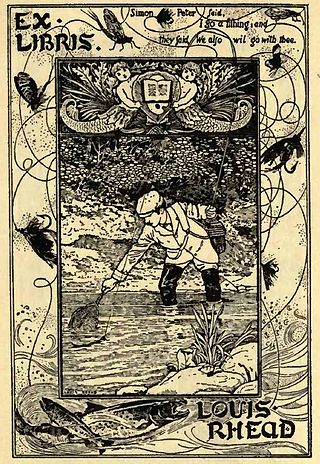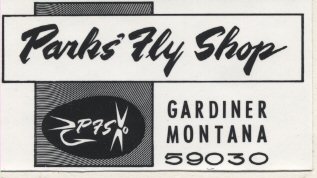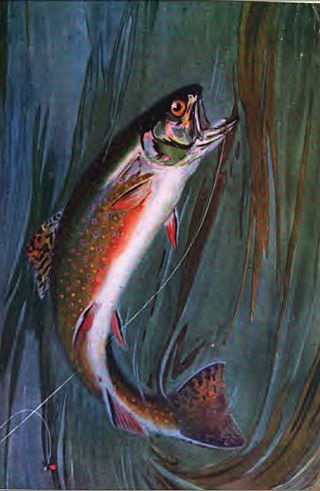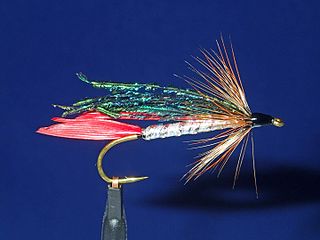Related Research Articles

Fly fishing is an angling technique that uses an ultra-lightweight lure called an artificial fly, which typically mimics small invertebrates such as flying and aquatic insects to attract and catch fish. Because the mass of the fly lure is insufficient to overcome air resistance, it cannot be launched far using conventional gears and techniques, so specialized tackles are used instead and the casting techniques are significantly different from other forms of angling. It is also very common for the angler to wear waders, carry a hand net, and stand in the water when fishing.
Orvis is an American family-owned retail and mail-order business specializing in fly fishing, hunting and sporting goods. Founded in Manchester, Vermont, in 1856 by Charles F. Orvis to sell fishing tackle, it is the oldest mail-order retailer in the United States.

Fly tying is the process of producing an artificial fly used by fly fishing anglers to catch fish. Fly tying is a manual process done by a single individual using hand tools and a variety of natural and manmade materials that are attached to a hook. Although the recent history of fly tying dates from the middle 1800s, fly tyers were engaged in tying flys since at least 200 AD.

An artificial fly or fly lure is a type of fishing lure, usually used in the sport of fly fishing. In general, artificial flies are an imitation of aquatic insects that are natural food of the target fish species the fly fishers try to catch. Artificial flies are constructed by fly tying, in which furs, feathers, thread or any of very many other materials are tied onto a fish hook.

This general annotated bibliography page provides an overview of notable and not so notable works in the English language regarding the sport of fly fishing, listed by year of first publication. Although not all the listed books are devoted exclusively to fly fishing, all these titles contain significant fly fishing content. The focus of the present page is on classic general texts on fly fishing and its history, together with notable public or university library collections dedicated to fly fishing.

Favorite Flies and Their Histories - With many replies from practical anglers to inquiries concerning how, when and where to use them-Illustrated by Thirty-two colored plates of flies, six engravings of natural insects and eight reproductions of photographs is a fly fishing book written by Mary Orvis Marbury published in Boston in April 1892 by Houghton Mifflin. It was considered by most fly fishers as the standard reference on flies in its era.

Blacker's Art of Fly Making - comprising angling and dyeing of colours with engravings of Salmon and Trout flies shewing the process of the gentle craft as taught in the pages with descriptions of flies for the season of the year as they come out on the water is a work of fly tying literature with significant fly fishing content written by William Blacker, a London tackle dealer and first published in London in 1842 by George Nichols. The 1842 and 1843 editions were only 48 pages while, the 1855 edition was considerably expanded by Blacker with hand-painted, colored illustrations and 252 pages.

Dan Bailey was a fly-shop owner, innovative fly developer and staunch Western conservationist. Born on a farm near Russellville, Kentucky, Bailey is best known for the fly shop he established in Livingston, Montana in 1938. Dan Bailey's Fly Shop is still in business.

Parks' Fly Shop is a fly shop and licensed fly fishing outfitter in Gardiner, Montana. In business since 1953, the shop located at 202 2nd Street between Main and Stone is the oldest business in Gardiner under continuous family ownership.

This annotated bibliography is intended to list both notable and not so notable works of English language, non-fiction and fiction related to the sport of fly fishing listed by year published. Although 100% of any book listed is not necessarily devoted to fly fishing, all these titles have significant fly fishing content. Included in this bibliography is a list of species related fly fishing literature.

This annotated bibliography is intended to list both notable and not so notable works of English language, non-fiction and fiction related to the sport of fly fishing listed by year published. Although 100% of any book listed is not necessarily devoted to fly fishing, all these titles have significant fly fishing content. Included in this bibliography is a list of fly tying, fly tackle, regional guides, memoirs, stories and fly fishing fiction related literature.
Lee Wulff, born Henry Leon Wulff, was an artist, pilot, fly fisherman, author, filmmaker, outfitter and conservationist who made significant contributions to recreational fishing, especially fly fishing and the conservation of Atlantic Salmon.

The Elk Hair Caddis is a dry fly commonly used for trout fishing. The Elk Hair Caddis was created by Pennsylvania fly tyer Al Troth in 1957. He is considered a pioneer in the sport of fly fishing for this invention.

The Royal Wulff is a popular artificial fly used for dry fly fishing. It is an attractor pattern and a descendant of both the Royal Coachman fly and the Wulff style of hair wing flies named for Lee Wulff.
The Trout and Salmonid Collection is a special collection of literature and archives in the Montana State University Library's Merrill G. Burlingame Special Collections Library. The collection is also known as The Bud Lilly Trout and Salmonid Collection, named after Bud Lilly who was instrumental in starting the collection. The approximately 20,000-volume collection, established in 2000, is devoted to preserving literary, scientific, government and media resources related to all aspects of trout and other salmonids. The collection contains materials in many languages and is not restricted by geography. It is considered a world-class collection of international significance relative to the study of trout and salmonids.

The Alexandra wet fly is an artificial fly. Also known as the Lady of the Lake, the fly was named by English angler Major William Greer Turle to honour Alexandra, Princess of Wales. The fly is distinguished by the heavy peacock herl wing and silver body which makes the fly resemble a small baitfish or fry. The Alexandra proved to be a very effective fly for trout in lakes and streams in England and Scotland in the late 19th and early 20th century. Many fly fishing purists derided the fly and its use was once banned on many English waters.
Andrew "Drew" Chicone is an American author, saltwater fly designer, fly fisherman and fly casting instructor. He writes books and magazine articles demonstrating how to tie saltwater fly patterns, primarily focused on warm-water fish and fly fishing from standup paddleboards.

The Wulff series of dry flies evolved from a dry fly style conceived by angler Lee Wulff in the 1930s.

A.K. Best is a production fly tyer, fly fisher, and angling writer. He was born in 1933 in Iowa and now lives in Colorado. He wrote for angling magazines like Fly Rod and Reel, Fly Fisherman, and Mid-Atlantic Fly Fishing Guide, and published several books on fly tying and fishing. His flies were sold in stores nationwide, as well as from online vendors. Best travels to speak about fly tying at angling clubs nationwide.
References
- 1 2 3 4 5 Hultman, Heather (9 September 2019). "John Gierach Papers". Montana State University Archives and Special Collections.
- 1 2 3 Catskills Fly Fishing Center and Museum (1 October 2015). "John Gierach". Catskills Fly Fishing Center and Museum.
- 1 2 Chelius, Ryan (April 20, 2023). "Q&A with John Gierach on his new book "All the time in the world"". Field and Stream.
- ↑ Ulf, Borjesson (6 November 2006). "A.K. Best, flugbindare". Flugfiske I Norden. 28.
- ↑ John Gierach, https://arc.lib.montana.edu/angling-oral-history/item/7 , Angling Oral History Project, Montana State University (MSU) Library, Bozeman, MT
- 1 2 Morgan, Lawrence E. (Spring–Summer 2008). "Trout fishing in America". Weber Journal. 24 (3).
- ↑ Gierach, John (April 19, 1992). "On the South Platte, Pushing Our Luck". The New York Times. p. 9.
- ↑ Deeter, Kirk (24 July 2019). "Trout magazine welcomes John Gierach and Bob White". Trout Unlimited.
- ↑ Lehmann-Haupt, Christopher (April 1, 1991). "Books of the times; Fly-fishing and Other Essentials". The New York Times. p. 15.
- ↑ Cornett, Linda (April 23, 1984). "All Tied Up in His Work". The Boulder Daily Camera.
- ↑ Umpqua Feather Merchants. "A.K. Best - Signature Tyers". Umpqua Feather Merchants.
- ↑ Monahan, Phil (May 31, 2023). "Video: How to tie an A.K. Best Spent Caddis". Orvis News.
- ↑ Gierach, John. 1989. Introduction. In: Best, A.K. (1989). Production Fly Tying. Pruett Publishing Company.
- ↑ "Federation of Flyfishers Awards-Past Recipients". Archived from the original on 2010-06-20. Retrieved 2010-03-30.